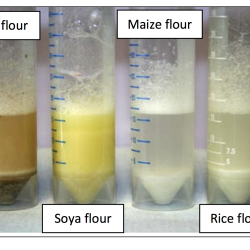Source Institutions
Source Institutions
Add to list Go to activity
Activity link broken? See if it's at the internet archive

In this activity (Page 30 of PDF), learners investigate the evolution of wheat by conducting sedimentation tests on different flours. The evolution of wheat from wild grasses demonstrates the dramatic effect of both natural and directed evolution on the structure of a crop plant and the chemical makeup of the product harvested from it. These activities illustrate the changes to both the structure and the chemistry of the wheat plant. Note: Sedimentation test can also be done using SDS detergent and lactic acid instead of soap and vinegar.
- Under 5 minutes
- 10 to 30 minutes
- $5 - $10 per group of students
- Ages 8 - adult
- Activity, Demonstration, Experiment/Lab Activity
- English
Quick Guide
Materials List (per group of students)
- 2 g of different types of flour (examples: bread flour, all purpose flour, spelt flour, rice flour, rye flour, maize flour)
- 8 ml of water for each type of flour
- 1 ml vinegar for each type of flour
- 6 ml dish washing soap for each type of flour
- 1 test tube for each type of flour (preferably 50 ml plastic tube with a screw cap)
Subjects
-
Engineering and Technology
-
Engineering
- Agricultural Engineering
-
Engineering
-
Life Sciences
-
Ecology
- Biodiversity
-
Evolution
- Evidence for Evolution
-
Ecology
Informal Categories
- Food and Cooking
Audience
To use this activity, learners need to:
- see
- touch
Learning styles supported:
- Involves hands-on or lab activities
Other
This resource is part of:
Access Rights:
- Free access
By:
Rights:
- All rights reserved, Biotechnology and Biological Sciences Research Council, 2012
